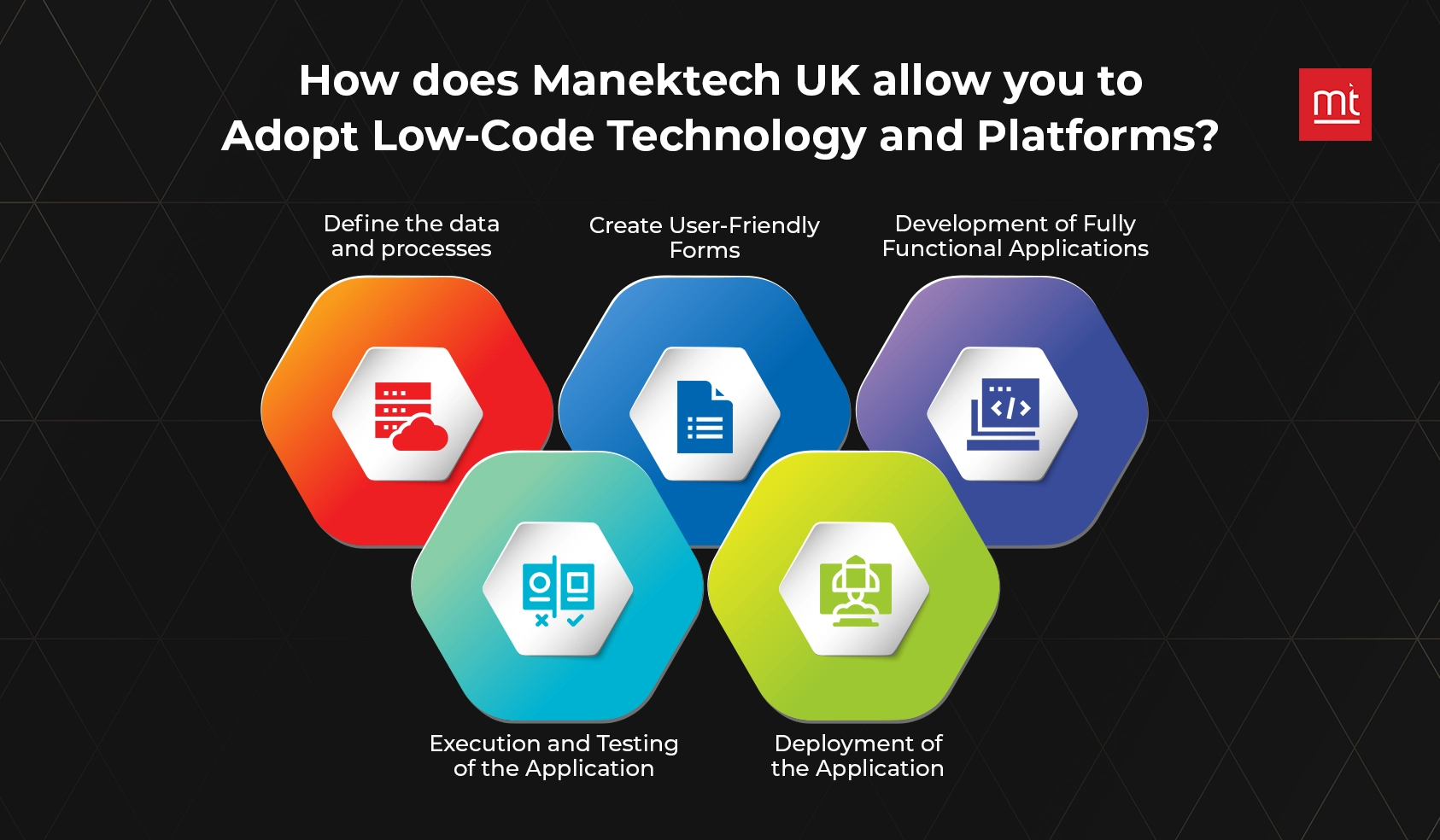Coding is an essential component of programming and developing a solution that resolves many technical issues. Experienced developers and programmers work hard to code a variety of applications and programs using diverse technology stacks.
Who does not love creating the best quality software with minimal coding and having no extensive coding experience? Low-code development platforms providing base-level coding, scripts, and integrations enable developers and companies to easily prototype, build, and scale applications without needing to deal with complex infrastructures.
Low-code platforms are different from no-code platforms, but they focus on providing high-level functionality for apps with customized coding. Basically, low-code app development methods elevate the coding experience of the users from texting to visualization.
Let’s get well acquainted with the topic and know what low-code development is before reaching out to low-code development platforms.

What is low-code development?
As a trusted software development approach, low-code app and software development requires minimum coding to build the finest quality applications and processes. Here, developers employ visual interfaces utilizing basic development logic and drag-and-drop facilities rather than using complex programming languages. As the experts suggest, low-code products are the most convenient, quick, and simple alternative to conventional development practices, and this is the reason why these development platforms are significantly growing among their customers and fellow developers.
Low-coding platforms make coding simple and app development more accessible, letting employees create their own solutions while maintaining IT governance. Generally, people think that such applications facilitate the development of low-code apps for small-scale projects where simple coding is needed. In reality, these apps are like powerful tools that efficiently manage and streamline the operations of complex and large-scale businesses, making their technological toolkit a superfluous and versatile asset for the businesses.
Low-code platforms provide a flexible and visual environment for developers to create simple to complex applications with a graphical interface. These platforms come with advanced tools like intuitive UI, pre-built templates, drag-and-drop models, etc. so that the developers and designers can design and deploy the apps at a faster pace and help their organizations achieve scalable and profitable returns. In comparison to the conventional hand-coding environment, low-code development facilitates the creation of software applications using a programming environment involving graphical user interfaces and configuration.

Why are low-coding platforms popular?
While developing a software or application product, the development teams definitely find themselves under a lot of pressure to meet their customers’ expectations and accelerate efforts related to the digital transformation of businesses. The rising demand for creating new and advanced business solutions forces them to slow down and perform much better than what is expected.
Simultaneously, the traditional tools, processes, and development methodologies are hardly designed to keep pace with the trending need for speed and the abrupt level of SaaS adoption that always comes with letting the business wheel freely and reach the point where they could not hinder their progress but instead take it to heights.
Hiring development talent is, however, another difficult task, as the world full of engineers still lacks someone who can satisfy each and every need of the tech business. Hence, the trend of adopting low-code technology has emerged and is flourishing, giving businesses an opportunity to present their talent and abilities at a limited level and with limited resources.
Nominal Features of Low-Code Platforms
Low-code platforms have enabled developers and business users to create visual programming-based applications that further reduce the need for conventional coding, thus accelerating the productivity of the developers. So, today, when the expectations of consumers are constantly changing, companies are eagerly searching for tools and techniques that facilitate hybrid working, and with the rise of low-code technology, the competition in the market has also gotten fierce.
Amitha Pulijala from Vonage, handling product, cloud platform services, CX, API, and AI at the company as a Vice President, shared that the low-code and no-code tools significantly mitigate the talent shortages as they allow companies and businesses to develop software systems without even needing a large team of developers.
Each of the two low-code solutions is different in its features and capabilities. However, they should include some of the below-given features to be regarded as low-code platforms, essentially:
- Visual IDE enables the design and development of applications using the drag-and-drop feature.
- Reusable components are the library of pre-built components that are needed to be assembled to build apps.
- Automated code generation eliminates tedious tasks.
- Model-driven app development approach by defining business rules and logic rather than just involving text-based codes.
- Integrations with databases and enterprise systems using connectors
- Multiplatform deployment of the applications using web, mobile, and cloud platforms.
- Absolute collaboration and version-control features enable multiple users to work on the same app.
- Built-in security measures and administration using role-based access controls and data privacy.
- Application lifecycle management tools for automatically building, debugging, deploying, and maintaining applications in multiple environments
Benefits of Low-Code Development for the Digital Transformation of Businesses
Low-code development is significantly growing in the market, and the popularity of such platforms is expected to rise by $29 billion in revenue by 2025. As Gartner reveals, 70% of the new apps and programs developed by enterprises are based on low-code and no-code technologies.
Low-code is extremely helpful for digital business transformation because it covers modernizing the important technologies to bring fundamental change, enable innovation, ensure higher efficiency, and achieve greater business agility. The ultimate advantage is unlocking value for the customers, shareholders, and employees of their organization. However, there are three common characteristics behind all digital transformation efforts: increased agility of businesses, significant collaboration between IT and businesses, and accelerated innovation cycles.

Low-code tools have not just become popular due to empowering professional developers but also a range of non-technical business professionals to collaborate to build applications that their businesses require for their digital transformation efforts. These tools are meant to remove all the complexities from software development and allow organizations to enhance the pace of development of their simple departmental applications while also relieving the backlog of the IT department. This helps them work on their objectives more impactfully and instinctively.
Some of the most significant advantages of these tools are stated below:
1. Increased Agility: These tools help to create and deploy new apps quickly and easily without needing extensive development knowledge from the developers. Thus, this enables organizations to become more agile and responsive to the changing needs of their businesses.
2. Safeguards from Technical Debts: Low-code platforms actually assist in preventing technical debts for an enterprise. These tools provide structured and standardized environments to develop various applications and reduce the risk of poor codes and shortcuts that further lead organizations into technical debt.
3. Cost Reduction: Low-code platforms reduce the requirement for specialized programming resources, which helps in ensuring lower development costs. Low-code also automates repetitive tasks, which further reduces costs. Also, always provide apps tailored to the specific needs of the users for a better user experience.
4. Faster Time-to-Market: These tools speed up the process of app development by helping organizations acquire new products and services to market at a faster pace.
5. Improved Decision Making: By providing access to real-time data and insights, low-code platforms help the owners make better data-driven decisions that can improve the overall performance of a business.
6. Access to New Methods and Technologies: The role of low-code tools is quite significant in enterprise modernization. These platforms allow businesses to efficiently update their processes and systems, giving room to the significant possibilities of digital transformation involving less time, cost, and level of complexity. Leveraging the pre-built features and templates enables organizations to easily integrate cutting-edge technologies like artificial intelligence and machine learning, helping businesses stay competitive in today’s fastest-growing digital landscape.
However, now is the time if you have not embraced the culture of low-code development platforms yet. A seamless transition still depends on taking adequate measures. A new platform’s incorporation requires you to educate your team about its functionality and original restructuring.

How does Manektech UK allow you to adopt low-code technology and platforms?
1. Define the data and processes. Data processing is an important element of any application. Manektech UK initiates by defining the processes aligned with the needs of the businesses to acquire a structured flow. This helps in creating apps to affirm that the processes are undertaken in the right direction and are easier to achieve. Finding a path by implementing the process simulation and deriving new insights is also another way to accomplish this in this regard. Once you have acquired a set of defined processes, it becomes easier to collect the right and necessary type of data. Further, determine the required type of data needed to carry out the processes seamlessly from the initial stage to the final stage.
2. Create user-friendly forms. A seamless and perfect user experience enables the easy adoption of low-code practices. Intuitive forms based on defined processes and data are easier to create for collecting data using drag-and-drop features. Manektech UK presents a robust platform based on low-code technology that enables users to build forms dynamically, involving ready-to-select widgets and ser-based control. Of course, if you have created a perfect form using any field type and functionality, it will definitely help in building better apps.
3. Development of Fully Functional Applications Experts suggest that it is just a cakewalk to develop apps with low-code functionalities, and it needs minimal coding knowledge and training from the developers. A visual app-building approach is needed to empower all developers, from simple to complex applications. In fact, a large number of BPM or business process management software-provider companies have started using low-code solutions due to the need for a fascinating and simple approach to developing software products and emphasizing minimal coding needs. Modifying the default code can also be done to generate more advanced features in the app. However, business process automation is the most significant advantage of low-code platforms. Visual development features and pre-built apps help automate repetitive tasks that hardly require any human intervention. This ultimately saves the time and efforts of the employees, who can be better supplied to handle the critical business tasks.
4. Execution and Testing of the Application Every app goes through the testing phase before it is finally launched. This is helpful to identify if there are any technical glitches or issues in the app that could hamper its performance or affect the efficiency and performance of the processes. Low-code platforms provide an amazing testing environment where the recently developed application is scrutinized as well as tested a number of times to check whether it is going to serve its purpose or not. Necessary changes are made to the application based on the test results and user feedback received after making it live.
5. Deployment of the Application Low-code platforms facilitate flexible deployment of applications. This enables the installation, configuration, and set-up of fully functional apps with just a few clicks. Low-code platforms also provide real-time feature updates and fixes.
A Practical Take on Low-Code Technology When should I use it?
- Low-code tools make integrating an app with an external tool or platform easier.
- Hand-writing the HTML, CSS, and PHP codes using low-code platforms for a simple website consisting mostly of static content is rarely a sufficient reason.
- Using low-code technology is perfect for building dashboards or reporting tools for supporting business analytics. In fact, a wide number of business process management and ERP platforms facilitate integrated low-code tools.
- Applications supporting simple business processes like vendor contract approvals and customer data collection are worth involving low-code development. Integrations of low-code technology in BPM platforms help in easy app building, even for general professionals who are not actually coders.
Conclusion
Low-code development platforms generate source code as a basis for customization. It allows the developers to customize the HTML markup and source code as a primary function. These platforms integrate well with web services, databases, and APIs for connecting data.
